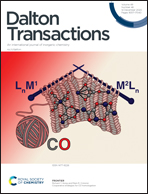Field-induced slow magnetic relaxation from linear trinuclear CoIII–CoII–CoIII to grid [2 × 2] tetranuclear mixed-valence cobalt complexes†
Abstract
By employing the ligand azotetrazolyl-2,7-dihydroxynaphthalene (H3ATD), two linear trinuclear mixed-valence cobalt complexes [CoIICoIII2(HATD)4(H2O)4]·4DMA·3H2O (1, DMA = N,N-dimethylacetamide) and [CoIICoIII2(HATD)4(DMF)2(H2O)2]·2DMF·2H2O (2, DMF = N,N-dimethylformamide) were synthesized. Two [2 × 2] grid-like tetranuclear ion-pair complexes [CoII2CoIII2(HATD)4(bpp)2(H2O)2][CoIII(HATD)2]2·8DMF·6H2O (3, bpp = 2,6-di(pyrazol-1-yl)pyridine) and [CoII2CoIII2(HATD)4(bpp)2(H2O)2][CoIII(HATD)2]2·8DMSO·4MeOH (4, DMSO = dimethyl sulphoxide) were obtained by the reaction of complex 1/2 with tridentate-chelating bpp in DMF and DMSO, respectively. The single-crystal X-ray diffraction analysis indicated that complexes 1 and 2 have a similar core, in which the DMA in 1 acts as a guest molecule, and the DMF in 2 acts as a coordinated molecule and guest molecule. Complexes 3 and 4 are isostructural. All the Co(II) ions in 1–4 are present in a distorted octahedral geometry. The ac susceptibility measurements show that all complexes display frequency-dependent peaks in the out-of-phase (χm′′) component of the alternating-current (ac) magnetic susceptibility data, which is the characteristic behavior of single molecule magnets (SMMs).
![Graphical abstract: Field-induced slow magnetic relaxation from linear trinuclear CoIII–CoII–CoIII to grid [2 × 2] tetranuclear mixed-valence cobalt complexes](/en/Image/Get?imageInfo.ImageType=GA&imageInfo.ImageIdentifier.ManuscriptID=D0DT02863K&imageInfo.ImageIdentifier.Year=2020)


 Please wait while we load your content...
Please wait while we load your content...